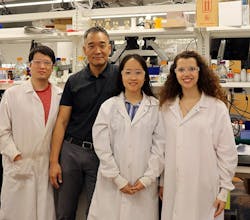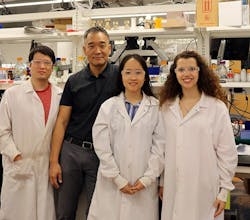Single Atom Catalyst Targets Tough Pollutants
A new single-atom catalyst (SAC) capable of breaking carbon-fluorine bonds offers a breakthrough for pollution remediation efforts, say a team of researchers from Yale University, New Haven, Conn., and the U.S. Department of Energy’s Brookhaven National Laboratory, Upton, N.Y.
Figure 1. Researchers at Yale University found single platinum atoms loaded onto silicon carbide could effectively break carbon-fluoride bonds. Source: Yale University.
“We aimed to develop a technology that could degrade polyfluoroalkyl substances (PFAS), one of the most challenging pollutant remediation problems of the present day,” explains Jaehong Kim, a professor in the department of chemical and environmental engineering at Yale. “Currently, there are no energy-efficient methods to destroy these contaminants. Our collaboration with Brookhaven Lab aims to solve this problem by taking advantage of the unique properties of single atom catalysts.”
Optimizing the efficiency of catalysts requires breaking them down to nanoscale materials and, if possible, into single atoms. The challenge is that individual atoms don’t behave the same as larger catalysts; sometimes, unwanted side reactions occur. An effective SAC requires a strong, reactive metal combined with a stable, complementary environment. Single atoms of platinum fit these requirements for breaking C-F bonds.
“Our team at Yale recently developed a readily scalable method to synthesize single-atom catalysts in two simple steps,” says Kim. “First, we bind metals to anchor sites on a support material, then we photo-reduce the metals to single atoms under mild UV-C irradiation. Using this method, our group has been synthesizing a suite of SACs involving various metals (platinum, palladium, and cobalt) and supports (silicon carbide, carbon nitride, and titanium dioxide) for numerous catalytic reactions. In this work, we found single platinum atoms loaded onto silicon carbide to be strikingly effective in catalyzing carbon-fluoride bond cleavage and breaking down contaminants like PFAS.”
“We expect that the active species (i.e., hydrogen atom) efficiently generated by Pt1/SiC could be applied for degradation of other halogenated contaminants; for instance, polychlorinated biphenyl and polybrominated biphenyl ether in addition to polyfluoroalkyl substances,” he adds.
Because the Pt synthetic method can be readily expanded to synthesize other SACs on other substrates, the team has successfully prepared Pd and Au SACs. “We are currently exploring a way to synthesize transition metal SACs (e.g., Fe, Cu, Co, Ni),” Kim notes.
The researchers used Brookhaven’s advanced transmission electron microscope to get a close-up view of the platinum atoms on the silicon carbide support. An ultrabright x-ray light and inner-shell spectroscopy allowed the scientists to “see” how the SAC was built. More details appear in a recent ACS Catalysis article.
While the team developed a simple, scalable synthesis method that requires relatively mild conditions, they don’t have any plans for larger scale synthesis.
Next, the researchers will focus on improving the mechanistic understanding of single atom coordination environment and the relationship to its catalytic performance. “We also plan to apply SACs for degradation of other PFAS and other halogenated pollutants,” says Kim. Testing the catalyst for degrading perfluoroalkyl substances also is ongoing.
One common concern for SAC application is the aggregation of single atoms, notes Kim. “We confirmed through XAFS [Extended X-ray absorption fine structure spectroscopy] analysis Pt SAC remained atomically dispersed after the reaction. The catalyst’s susceptibility to poisoning by other water components and long-term robustness remain to be determined by further research,” he adds.
In addition, SAC research is at an embryonic phase; fundamental mechanisms remain unclear (even contradictory in some cases), cautions Kim.

